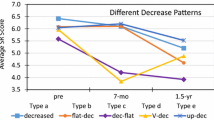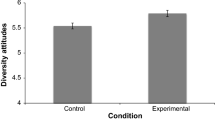Abstract
This study tested the effect of a message describing a social norm of egalitarian attitudes and behaviors in an engineering college on male students’ attitudes and behavioral intentions surrounding diversity in engineering. Participants were first-semester university students enrolled in four sections of an introductory engineering course in two academic terms (Fall 2009 and Fall 2011). At the beginning of the semester, students in two of the four sections received the egalitarian social norms message in the form of an oral presentation given by a senior White male faculty member (social norms message condition). Students in the other two sections did not receive this presentation (control condition). At the end of the semester, all students were invited to complete a survey. Results from a sample of 129 students showed that compared to the control condition, male students in the social norms message condition had stronger intentions to speak out against racist behaviors in their engineering courses and teams, and (among White compared to racial minority men) more positive attitudes toward diversity in engineering. These results suggest that setting a tone of egalitarianism and intolerance of bias for incoming students could help create a more inclusive environment in a White male-dominated educational setting such as a college of engineering.
Similar content being viewed by others
Notes
Although Asians and Asian Americans are not underrepresented in engineering, they still face stereotyping and discrimination (Trytten et al. 2012), so they are included as a minority group in our analyses. Additionally, we analyzed our results using 3 racial categories, and we note that there are no differences between Asian/South Asian students and other racial minority students.
Analyses retaining all participants revealed a similar significant condition by race group interaction on diversity in engineering attitudes as was reported for the final sample, \(F(1{,} 147) = 3.94,\) \(p < .05\); the condition by bias type interaction on intentions to confront racist/sexist remarks did not reach statistical significance, \(F(1, 141) = 2.82\), \(p = .09\).
A paired-samples t test comparing our covariates (how often participants reported hearing derogatory comments made about women or racial minorities in their engineering courses), reveals that participants reported hearing significantly more derogatory comments made about women (\(M = 1.96, { SD} = 1.37)\) than derogatory comments made about racial minorities (\(M = 1.78, { SD} = 1.17), t(128) = 2.13, p < .05\). This may lend additional weight to the frequency (or acceptability) argument.
References
Bator, R. J., & Cialdini, R. B. (2000). The application of persuasion theory to the development of effective proenvironmental public service announcements. Journal of Social Issues, 56, 527–541.
Boysen, G. A., & Vogel, D. L. (2009). Bias in the classroom: Types, frequencies, and responses. Teaching of Psychology, 36(1), 12–17.
Ceci, S. J., & Williams, W. M. (2010). Sex differences in math-intensive fields. Current Directions in Psychological Science, 19, 275–279.
Cialdini, R. B., Reno, R. R., & Kallgren, C. A. (1990). A focus theory of normative conduct: Recycling the concept of norms to reduce littering in public places. Journal of Personality and Social Psychology, 58(6), 1015–1026.
Cialdini, R. B., Demaine, L. J., Sagarin, B. J., Barret, D. W., Rhoads, K., & Winter, P. L. (2006). Managing social norms for persuasion impact. Social Influence, 1(1), 3–15.
Cole, E. R. (2009). Intersectionality and research in psychology. American Psychologist, 64(3), 170–180.
Cowan, G., & Hodge, C. (1996). Judgments of hate speech: The effects of target group, publicness, and behavioral responses of the target. Journal of Applied Social Psychology, 26, 355–374.
Crandall, C., Eshleman, A., & O’Brien, L. (2002). Social norms and the expression and suppression of prejudice: The struggle for internalization. Journal of Personality and Social Psychology, 82, 359–378.
Czopp, A. M., & Monteith, M. J. (2003). Confronting prejudice (literally): Reactions to confrontations of racial and gender bias. Personality and Social Psychology Bulletin, 29, 532–544.
Fishbein, M., & Ajzen, I. (1974). Attitudes towards objects as predictors of single and multiple behavioral criteria. Psychological Review, 81(1), 59–74.
Gaertner, S. L., & Dovidio, J. F. (1986). The aversive form of racism. In J. F. Dovidio & S. L. Gaertner (Eds.), Prejudice, discrimination, and racism (pp. 61–89). San Diego, CA: Academic Press.
Glick, P., & Fiske, S. T. (2012). An ambivalent alliance: Hostile and benevolent sexism as complementary justifications for gender inequality. In J. Dixon & M. Levine (Eds.), Beyond prejudice: Extending the social psychology of conflict, inequality and social change (pp. 70–88). New York, NY: Cambridge University Press.
Hopper, J. R., & Nielsen, J. M. (1991). Recycling as altruistic behavior: Normative and behavioral strategies to expand participation in a community recycling program. Environment and Behavior, 23(2), 195–220.
Hovland, C. I., & Weiss, W. (1951). The influence of source credibility on communication effectiveness. Public Opinion Quarterly, 15, 635–650.
Keller, K. L. (1987). Memory factors in advertising: The effect of advertising retrieval cues on brand evaluations. Journal of Consumer Research, 14(3), 316–333.
Lubinski, D., & Benbow, C. P. (2006). Study of mathematically precocious youth after 35 years: Uncovering antecedents for the development of math-science expertise. Perspectives on Psychological Science, 1(4), 316–345.
Meadows, L., & Sekaquaptewa, D. (2011). The effect of group gender composition on student participation and learning in undergraduate engineering project teams. In Proceedings of ASEE annual conference, Vancouver, BC, Paper 2011–1319, 13 pp., June 2011.
Monteith, M. J., & Spicer, V. C. (2000). Contents and correlated of Whites’ and Blacks’ racial attitudes. Journal of Experimental Social Psychology, 36(2), 125–154.
Monteith, M. J., Ashburn-Nardo, L., Voils, C. I., & Czopp, A. M. (2002). Putting the brakes on prejudice: On the development and operation of cues for control. Journal of Personality and Social Psychology, 83(5), 1029–1050.
Murphy, M. C., Steele, C. M., & Gross, J. J. (2007). Signaling threat: How situational cues affect women in math, science, and engineering settings. Psychological Science, 18(10), 879–885.
National Science Foundation, Division of Science Resources Statistics (2012). Women, minorities, and persons with disabilities in science and engineering: 2010, NSF 11–309 (Arlington, VA).
Pratkanis, A. R., & Greenwald, A. G. (1993). Consumer involvement, message attention, and the persistence of persuasive impact in a message-dense environment. Special Issue: Involvement, 10(4), 321–332.
Reno, R. R., Cialdini, R. B., & Kallgren, C. A. (1993). The transsituational influence of social norms. Journal of Personality and Social Psychology, 64(1), 104–112.
Schultz, P. W., Nolan, J. M., Cialdini, R. B., Goldstein, N. J., & Griskevicius, V. (2007). The constructive, destructive, and reconstructive power of social norms. Psychological Science, 18, 429–434.
Sherif, M., & Sherif, C. W. (1953). Groups in harmony and tension. New York: Harper.
Sritharan, R., & Gawronski, B. (2010). Changing implicit and explicit prejudice: Insights from the associative-propositional evaluation model. Social Psychology, 41(3), 113–123.
Stangor, C., Sechrist, G., & Jost, J. T. (2001). Changing racial beliefs by providing consensus information. Personality and Social Psychology Bulletin, 27, 486–496.
Steele, C. M., Spencer, S. J., & Aronson, J. (2002). Contending with group image: The psychology of stereotype and social identity threat. In M. P. Zanna (Ed.), Advances in experimental social psychology (pp. 379–440). San Diego, CA: Academic Press.
Steinpreis, R. E., Anders, K. A., & Ritzke, D. (1999). The impact of gender on the review of the curricula vitae of job applicants and tenure candidates: A national empirical study. Sex Roles, 41(7–8), 509–528.
Thompson, M., & Sekaquaptewa, D. (2002). When being different is detrimental: The influence of solo status on the performance of women and racial minorities. Analyses of Social Issues and Public Policy, 2, 183–203.
Trytten, D. A., Wong Lowe, A., & Walden, S. E. (2012). “Asians are good at math. What an awful stereotype”: The model minority stereotype’s impact on Asian American engineering students. Journal of Engineering Education, 101(3), 439–468.
Wai, J., Cacchio, M., Putallaz, M., & Mackel, M. C. (2010). Sex differences in the right tail of cognitive abilities: A 30 year examination. Intelligence, 38(4), 412–423.
Acknowledgments
This research was conducted with support from the University of Michigan College of Engineering, and the UM-ADVANCE program. Special thanks to Wayne Jones, Abby Stewart, Lorelle Meadows, and James Holloway for their assistance.
Author information
Authors and Affiliations
Corresponding author
Rights and permissions
About this article
Cite this article
Bennett, J.E., Sekaquaptewa, D. Setting an egalitarian social norm in the classroom: improving attitudes towards diversity among male engineering students. Soc Psychol Educ 17, 343–355 (2014). https://doi.org/10.1007/s11218-014-9253-y
Received:
Accepted:
Published:
Issue Date:
DOI: https://doi.org/10.1007/s11218-014-9253-y




